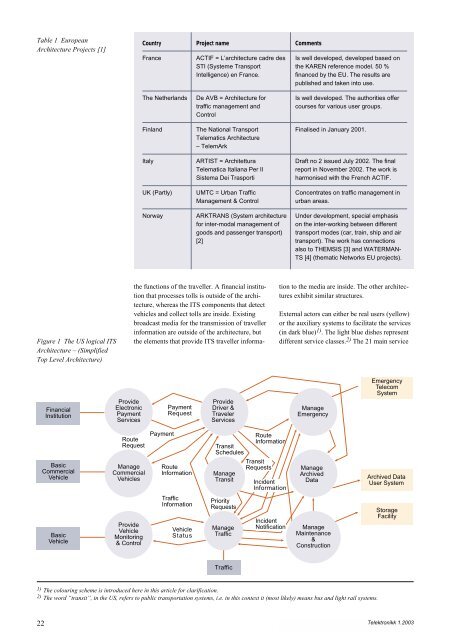Intelligent Transport Systems - Telenor
Intelligent Transport Systems - Telenor
Intelligent Transport Systems - Telenor
You also want an ePaper? Increase the reach of your titles
YUMPU automatically turns print PDFs into web optimized ePapers that Google loves.
Table 1 European<br />
Architecture Projects [1]<br />
Figure 1 The US logical ITS<br />
Architecture – (Simplified<br />
Top Level Architecture)<br />
22<br />
Financial<br />
Institution<br />
Basic<br />
Commercial<br />
Vehicle<br />
Basic<br />
Vehicle<br />
Provide<br />
Electronic<br />
Payment<br />
Services<br />
Manage<br />
Commercial<br />
Vehicles<br />
Provide<br />
Vehicle<br />
Monitoring<br />
& Control<br />
Country Project name Comments<br />
France ACTIF = L’architecture cadre des Is well developed, developed based on<br />
STI (Systeme <strong>Transport</strong> the KAREN reference model. 50 %<br />
Intelligence) en France. financed by the EU. The results are<br />
published and taken into use.<br />
The Netherlands De AVB = Architecture for Is well developed. The authorities offer<br />
traffic management and courses for various user groups.<br />
Control<br />
Finland The National <strong>Transport</strong> Finalised in January 2001.<br />
Telematics Architecture<br />
– TelemArk<br />
Italy ARTIST = Architettura Draft no 2 issued July 2002. The final<br />
Telematica Italiana Per Il report in November 2002. The work is<br />
Sistema Dei Trasporti harmonised with the French ACTIF.<br />
UK (Partly) UMTC = Urban Traffic Concentrates on traffic management in<br />
Management & Control urban areas.<br />
Norway ARKTRANS (System architecture Under development, special emphasis<br />
for inter-modal management of on the inter-working between different<br />
goods and passenger transport) transport modes (car, train, ship and air<br />
[2] transport). The work has connections<br />
also to THEMSIS [3] and WATERMAN-<br />
TS [4] (thematic Networks EU projects).<br />
the functions of the traveller. A financial institution<br />
that processes tolls is outside of the architecture,<br />
whereas the ITS components that detect<br />
vehicles and collect tolls are inside. Existing<br />
broadcast media for the transmission of traveller<br />
information are outside of the architecture, but<br />
the elements that provide ITS traveller informa-<br />
Route<br />
Request<br />
Payment<br />
Payment<br />
Request<br />
Route<br />
Information<br />
Traffic<br />
Information<br />
Vehicle<br />
Status<br />
Provide<br />
Driver &<br />
Traveler<br />
Services<br />
Transit<br />
Schedules<br />
Manage<br />
Transit<br />
Priority<br />
Requests<br />
Manage<br />
Traffic<br />
Traffic<br />
Route<br />
Information<br />
Transit<br />
Requests<br />
Incident<br />
Information<br />
Incident<br />
Notification<br />
tion to the media are inside. The other architectures<br />
exhibit similar structures.<br />
External actors can either be real users (yellow)<br />
or the auxiliary systems to facilitate the services<br />
(in dark blue) 1) . The light blue dishes represent<br />
different service classes. 2) The 21 main service<br />
Manage<br />
Emergency<br />
Manage<br />
Archived<br />
Data<br />
Manage<br />
Maintenance<br />
&<br />
Construction<br />
1) The colouring scheme is introduced here in this article for clarification.<br />
2) The word “transit”, in the US, refers to public transportation systems, i.e. in this context it (most likely) means bus and light rail systems.<br />
Emergency<br />
Telecom<br />
System<br />
Archived Data<br />
User System<br />
Storage<br />
Facility<br />
Telektronikk 1.2003
















